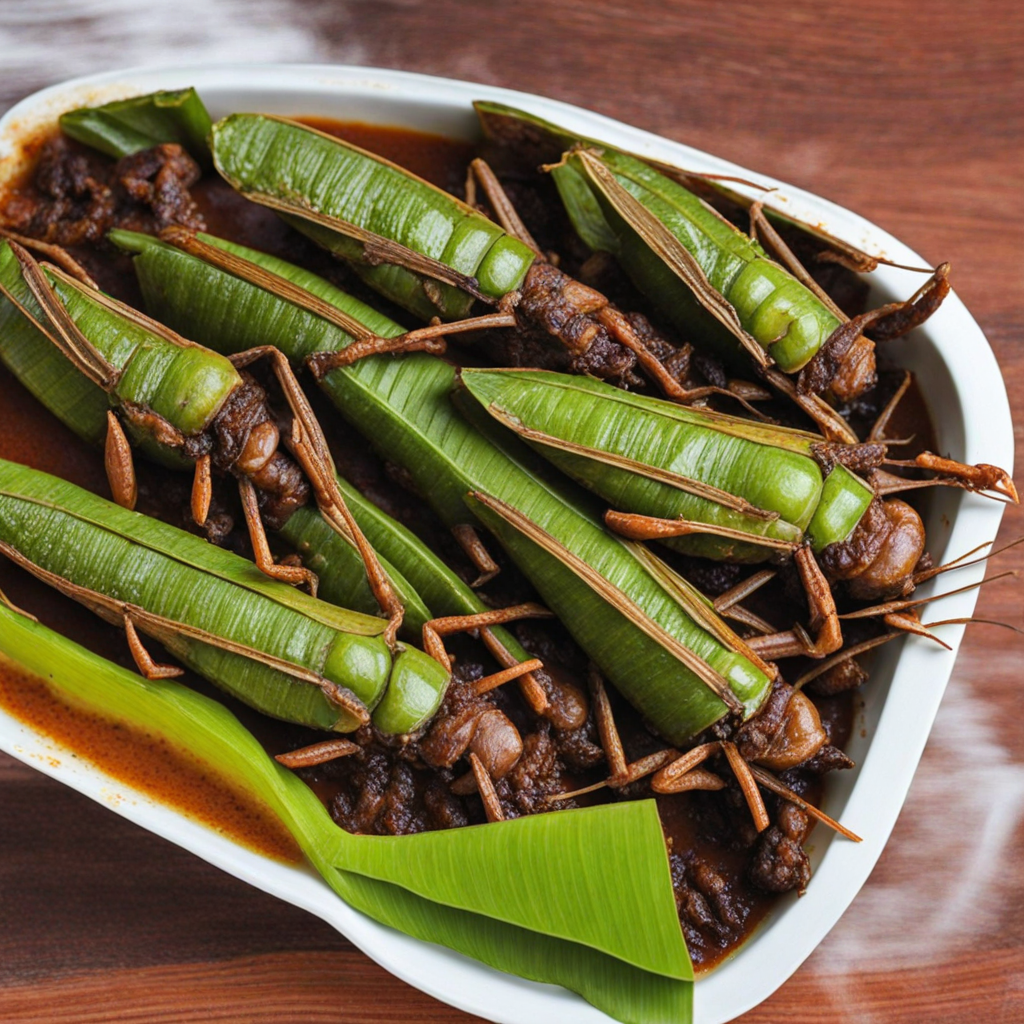Grasshopper Stew
Grasshopper Stew is a traditional Ugandan dish that brings a unique and adventurous flavor to the table. This hearty stew features the star ingredient, grasshoppers, which are known locally as "nsenene." Rich in protein and often considered a delicacy, these crunchy insects are usually harvested during the rainy season, adding a touch of seasonality to the dish. The grasshoppers are typically cleaned and sautéed with a blend of local spices, creating a savory base that enhances their natural nuttiness. As the stew simmers, a medley of vegetables such as tomatoes, onions, and bell peppers are added, giving the dish a vibrant color and an array of flavors. The vegetables not only provide essential nutrients but also complement the grasshoppers' earthy taste. Ugandan spices like garlic, ginger, and sometimes chili are used to elevate the flavor profile, making the stew aromatic and inviting. The combination of textures—from the tender vegetables to the crispy grasshoppers—creates a delightful contrast that keeps every bite interesting. When served, Grasshopper Stew is typically accompanied by staple Ugandan sides such as matoke (steamed green bananas) or posho (maize porridge), which help balance the dish's bold flavors. The stew is not only a culinary experience but also a cultural one, as it reflects the resourcefulness of Ugandan cuisine, where every ingredient is utilized to its fullest potential. For those looking to expand their palate, Grasshopper Stew offers a deliciously unique taste of Uganda that is both satisfying and memorable.
How It Became This Dish
Nsenene mu Luwombo: A Culinary Journey Through Uganda's Cultural Tapestry As dusk falls over the lush landscapes of Uganda, a unique culinary delight stirs to life—Nsenene mu Luwombo. This dish is a gastronomic emblem of Uganda, weaving together the threads of culture, tradition, and the rich biodiversity of the region. To understand Nsenene mu Luwombo, one must delve into its origins, cultural significance, and the evolution it has undergone over time. Origins of Nsenene Nsenene, or the edible grasshopper (Ruspolia differens), has been a part of the Ugandan diet for centuries. These insects are typically harvested during the rainy season, particularly from November to December, when they swarm in vast numbers. The practice of consuming grasshoppers is deeply rooted in the agricultural traditions of Uganda, where communities have relied on the seasonal bounty of the land for sustenance. Historically, the consumption of Nsenene can be traced back to ancient agricultural societies in Uganda, where the protein-rich insects provided an essential food source. For many rural communities, particularly in Buganda, the grasshopper harvest is not merely a culinary event but a communal activity, with families and neighbors coming together to catch and prepare the insects. Traditionally, Nsenene is collected at night, attracted by the light of torches or lanterns. This practice is a testament to the ingenuity of Ugandan communities, who have adapted to the rhythms of nature to make the most of their environment. Cultural Significance Nsenene mu Luwombo holds a special place in Ugandan culture. Luwombo itself is a traditional Ugandan stew, originally made with meat (often chicken or beef), vegetables, and groundnut (peanut) paste, all slow-cooked in a pot, typically a clay or wooden one. The term "Luwombo" is derived from the Luganda word "luwombo," which means "to stew." Over time, Luwombo has become a symbol of hospitality and communal sharing in Ugandan society. The incorporation of Nsenene into Luwombo reflects the adaptability and creativity of Ugandan cuisine. Grasshoppers, when cooked, impart a unique flavor, both nutty and savory, that complements the rich and aromatic sauce of Luwombo. The dish is often served during special occasions, family gatherings, and cultural celebrations, showcasing the importance of Nsenene mu Luwombo in Ugandan culinary traditions. Nsenene mu Luwombo is not only a staple in households but also a source of pride for Ugandans. It represents a connection to the land and the cultural heritage that has been passed down through generations. The dish is emblematic of the values of community and sharing, as it is often prepared in large quantities to cater to family and friends. Development Over Time The evolution of Nsenene mu Luwombo reflects broader changes in Ugandan society and cuisine. In recent years, there has been a renewed interest in indigenous foods and traditional practices, spurred by a growing awareness of food security, nutrition, and sustainability. As global food trends shift towards more sustainable and locally sourced ingredients, Nsenene has gained recognition not only as a delicacy but also as a viable protein source. The rise of urbanization in Uganda has also impacted the consumption patterns of Nsenene mu Luwombo. While traditionally a rural dish, it has found its way into urban restaurants and street food stalls, appealing to both locals and tourists. This shift has sparked creativity among chefs, who experiment with various ingredients and cooking techniques, blending traditional recipes with contemporary culinary practices. Moreover, the health benefits of insect consumption have garnered attention, positioning Nsenene as a nutritious alternative to conventional meat sources. Grasshoppers are rich in proteins, vitamins, and minerals, making them an attractive option for health-conscious consumers. This newfound appreciation has led to initiatives promoting the sustainable harvesting of Nsenene, ensuring that this culinary heritage can be enjoyed for generations to come. Contemporary Significance Today, Nsenene mu Luwombo is more than just a dish; it is a cultural phenomenon that embodies the spirit of Uganda. It serves as a reminder of the country's agricultural roots and the importance of preserving traditional food practices in an increasingly globalized world. Culinary festivals and events celebrating Ugandan cuisine often feature Nsenene mu Luwombo, showcasing the versatility and richness of local ingredients. The dish also plays a crucial role in fostering community ties. The process of gathering, preparing, and sharing Nsenene mu Luwombo reinforces social bonds among family and friends. In a world where fast food and convenience often overshadow traditional cooking, the communal experience of enjoying Nsenene mu Luwombo stands as a testament to the enduring significance of shared meals in Ugandan culture. Conclusion Nsenene mu Luwombo is a beautiful amalgamation of history, culture, and culinary art. Its origins in sustainable practices, coupled with its cultural significance and evolution over time, make it a remarkable dish that tells the story of Uganda's rich heritage. As the world continues to embrace diversity in cuisine, Nsenene mu Luwombo remains a cherished symbol of Ugandan identity, offering a taste of the land and its people. By savoring Nsenene mu Luwombo, one does not merely indulge in a delicious meal; one partakes in a narrative that spans generations, celebrating the resilience and creativity of Ugandan culinary traditions. Whether enjoyed in a bustling city restaurant or a humble family kitchen, Nsenene mu Luwombo invites all to experience the warmth and hospitality that is at the heart of Ugandan culture.
You may like
Discover local flavors from Uganda







